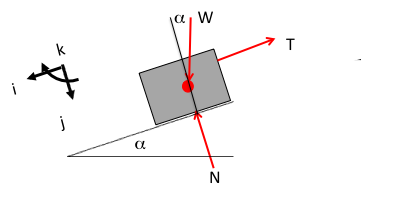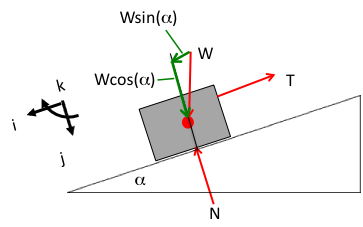 |
||||||||
 |
 |
 |
 |
|||||
 |
||||||||
 |
||||||||
 |
 |
|||||||
 |
||||||||
 |
||||||||
 |
||||||||
 |
||||||||
 |
||||||||
Example 2: Box on a ramp
Consider the box of weight, W on the ramp:
The cord is holding the box at the current position of the figure. What is the expression that defines the magnitude of the tension in the cord? What is the normal force of the ramp on the box?
In this example, motion is down the ramp, so the use of a Cartesian frame oriented parallel and normal to the ramp is most appropriate, as shown in Fig. 4↓. The weight is the only force that is not used immediately in the frame of reference. For equilibrium, the tension, T, must balance the component of the box weight that is parallel and down the ramp, as illustrated in Fig. 5↓.
Here, while the vector arrows are not to scale (and this is not a problem!), the equations of motion in equilibrium are very easy to write when looking at Fig. 5↑:
i: 0
=
Wsin(α) − T
j: 0
=
Wcos(α) − N
k: 0
=
0
or more simply
i: T
=
Wsin(α)
j: N
=
Wcos(α)
← Previous Page
← Previous Page


